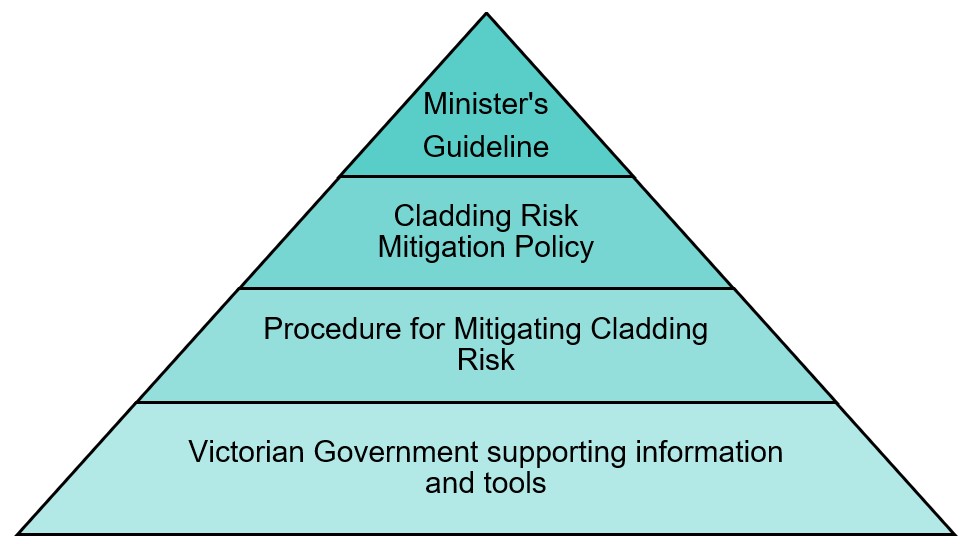1.1. Overview
1.1.1
The presence of combustible external cladding on existing residential buildings in Victoria may create a fire risk for the people who reside, use and visit those buildings. The level of threat posed to life is not the same for all buildings that have combustible external cladding as part of their façade structure.
1.1.2
The Victorian Government has invested significant resources to reduce risk on those buildings where the risk posed by combustible external cladding is the highest.
1.1.3
The use of high risk combustible external cladding on all new Type A and Type B buildings constructed from March 2018 was first restricted by Minister’s Guideline 14 and was subsequently prohibited under section 192B(1) of the Building Act 1993 (the Act).
1.1.4
For existing buildings with combustible external cladding, removing and replacing all or part of the cladding façade of a building is complex, time consuming and costly, but justifiable where the risk posed by combustible cladding is unacceptably high.
1.1.5
Minister’s Guideline 15 made under section 188(1)(c) of the Act was made for the purposes of:
- providing guidance to municipal building surveyors and private building surveyors when fulfilling their respective functions under the Act and the Building Regulations 2018 (the Regulations) in connection with combustible external cladding; and
- providing guidance as to how municipal building surveyors and private building surveyors should assess remediation work proposals for combustible external cladding where the remediation work proposal does not comprise the full removal and replacement of the combustible external cladding.
1.1.6
The Victorian Government has amassed significant cladding fire safety knowledge and science-based learning since the focus on combustible cladding in the existing built environment commenced. The strong evidence base that has been created is now being used to give definition to the findings of the Victorian Cladding Taskforce and provide the basis for a structured risk-based approach to be established.
1.1.7
This framework will remove uncertainty amongst municipal building surveyors, building owners and building practitioners about the practical and reasonable measures that can be taken to make a building sufficiently safe from a cladding fire risk perspective.
Cladding risk mitigation procedure framework

1.2. Purpose
1.2.1
This framework supports Minister’s Guideline 15 by:
- setting out the Victorian Government’s policy regarding a risk-based approach to combustible external cladding on certain buildings in Victoria (see Part 2 of this framework), which includes the objective that work be carried out on all relevant buildings so that those relevant buildings move to an acceptable cladding risk rating without, where possible, the removal and replacement of all combustible external cladding;
- setting out the criteria to determine a risk rating for certain buildings in Victoria which include combustible external cladding. In particular, this framework provides a basis for identifying the cladding risk ratings of buildings for the purpose of Minister’s Guideline 15 (see Part 2.2 of this framework); and
- providing a structured, risk-based approach to assessing remediation work proposals for relevant buildings to determine whether an acceptable cladding risk rating can be achieved without the full removal and replacement of all combustible external cladding (see Part 3 of this framework).
1.3. Definitions
1.3.1
In this framework:
‘Acceptable cladding risk’ means that the relevant building:
- achieves a ‘low cladding risk’ rating; or
- presents an overall level of risk to the life and safety of the occupants of the relevant building which is reasonably similar or less than the risk which would be presented by the same building, if that building had no combustible external cladding.
‘Act’ means the Building Act 1993.
‘Combustible external cladding’ means:
- aluminium composite panels (ACP) with a polymer core which is installed as external cladding, lining or attachments as part of an external wall system; and
- expanded polystyrene (EPS) products used in an external insulation and finish (rendered) wall system.
‘Elevated cladding risk’ has the meaning given in Table 1 in paragraph 2.2.2 of this framework.
‘Guideline’ means Minister’s Guideline 15 issued by the Minister pursuant to section 188(1)(c) of the Act, as amended or re-issued from time to time.
‘Low cladding risk’ has the meaning given in Table 1 in paragraph 2.2.2 of this framework.
‘NCC’ means the National Construction Code.
‘Relevant building’ has the meaning given under the heading ‘Buildings to which this guideline applies’ in the guideline.
‘Remediation work proposal’ means:
‘Combustible external cladding’ means:
- a proposal prepared by the owner of a relevant building or anyone authorised on their behalf for the work to address the combustible external cladding; or
- a proposal prepared by Cladding Safety Victoria to address the combustible external cladding;
on that relevant building.
‘SOUs’ means ‘sole occupancy units’, as that term is defined in the National Construction Code.
‘Sprinkler protected’ means that there are sprinklers internally throughout the relevant SOU.
‘Unacceptable cladding risk’ has the meaning given in Table 1 in paragraph 2.2.2 of this framework.
